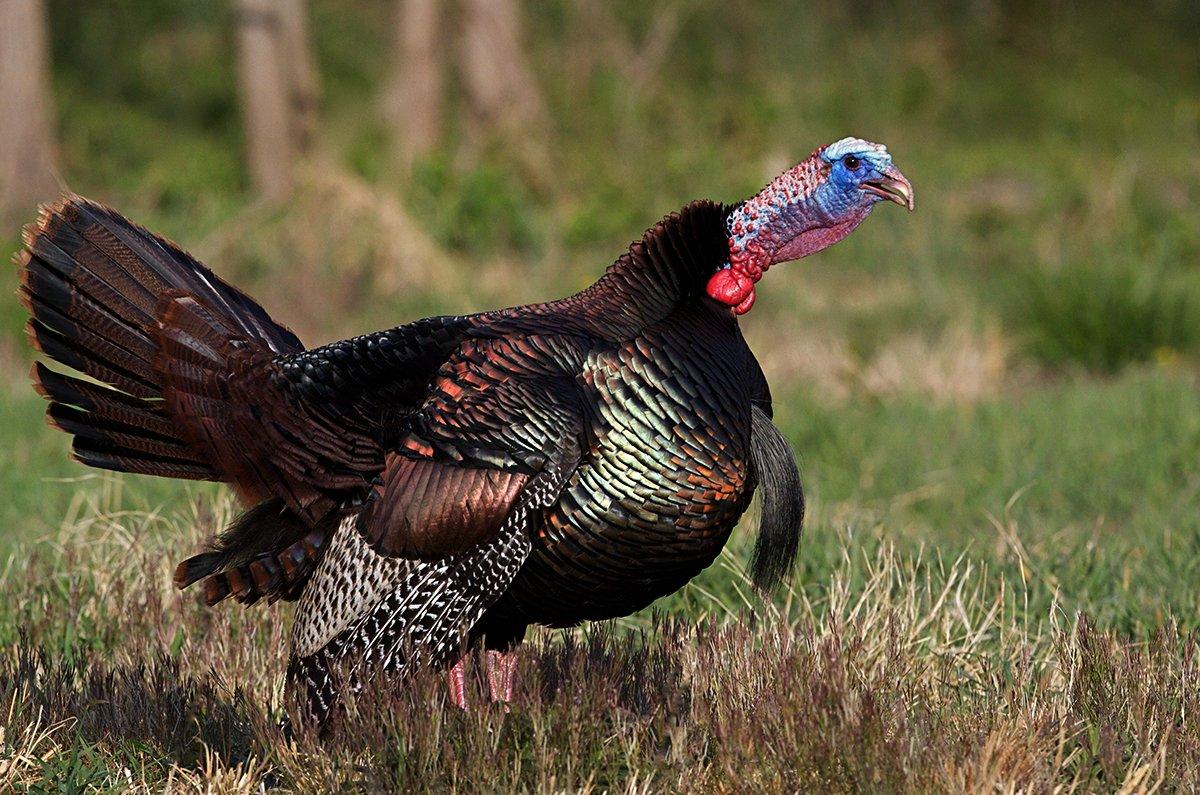For the most part, turkey numbers and good hunting continue to thrive in America's heartland
Bless the Midwest. In a time when turkey populations elsewhere seem to face never-ending challenges, this region — with a couple of exceptions — continues to provide quality hunting opportunities.
Moreover, hunters can find diversity here: big timber, sprawling ag country, endless prairie and river breaks, or combinations thereof. Is filling a tag guaranteed? Of course not. It's turkey hunting. But your odds of success will be good, and the experience promises to be memorable.
Here's a look at what Midwestern turkey hunters can expect during spring 2023.

Illinois
Two consecutive years of good nesting success have Illinois biologists feeling optimistic about the upcoming turkey season.
I'm not predicting a record-breaking harvest by any means, but I think we can expect to see a higher harvest total than the previous two years, which were well below average, said Luke Garver, wild turkey project manager with the Illinois Department of Natural Resources. Two straight years of very low poult-to-hen ratios in 2018 and 2019, followed by a 2020 spring harvest that was one of the highest in a decade, might have resulted in fewer birds on the landscape the past few seasons. Fingers are crossed for continued increases in nest success and, as always, for favorable spring weather.
Northwestern Illinois saw an especially high jump in reproductive success, as indicated by Illinois' Summer 2022 Brood Survey. Conversely, southern Illinois remains on a four-year skid for poult-to-hen ratios.
While the turkey population is still relatively high in that part of the state, bird numbers might not be what hunters have seen in the past, Garver said
(Read More: Turkey Hunting in Illinois)
Indiana
Parts of the Hoosier State have taken some hits the past decade in terms of turkey recruitment. However, biologists there say conditions have aligned to produce good news throughout the state.
It should be a good year for the Indiana spring turkey harvest, with increased harvests in most regions of the state, said Emily B. McCallen, biometrician with the Indiana Department of Natural Resources Division of Fish and Wildlife. Conducive warm and relative dry weather during the critical early brood period in June 2021, coupled with the 17-year Brood X cicada emergence, resulted in an exceedingly good production year in 2021. That means this spring, there should be more 2-year-old gobblers on the landscape and higher-than-normal success rates. We saw an increase in success rates in the fall 2022 harvest, and we expect that will continue into spring.
McCallen said the Brood X emergence brought a much-needed boost in brood production to the southeastern and south-central portions of the state, which had experienced more than a decade of depressed recruitment. Those regions historically hold the greatest turkey densities.
Meanwhile, Thomas A. Despot, northwest public lands supervisor with the Indiana DNR, said 2022 turkey production appeared to be good in the northern part of the state.
The early spring weather was cool and wet in April and May, but the weather turned warm and dry in June and July, he said. This corresponded with the main hatching and brood rearing time for wild turkeys in northern Indiana and provided very good weather conditions for brood survival. The turkey population in northern Indiana seems to have remained fairly stable over the past several years, and public and private lands have had good numbers of turkeys for the spring season.
(Read More: Turkey Hunting in Indiana)
Iowa
Jim Coffey, forest wildlife biologist with the Iowa Department of Natural Resources, said hunters should expect good numbers of turkeys throughout the state this spring.
Back-to-back years of above-average production have been observed in most areas, he said. There is no reason to think license sales or harvest will be different than in recent years.
The traditional turkey range of eastern Iowa looks particularly good.
Although southeastern Iowa is of concern, it has seen better production recently, Coffey said. Southwestern and west-central Iowa could be areas of concern.
(Read More: Turkey Hunting in Iowa)
Kansas
A popular turkey destination for years, the Sunflower State has experienced some challenges recently. However, biologists said prospects for spring 2022 are looking up.
Turkey hunting should be fair to good in Kansas in 2023, said Kent Fricke, small-game coordinator for the Kansas Department of Wildlife and Parks. Production decreased slightly in 2022 compared to 2021, but populations are still recovering from very low production in 2019 because of extensive precipitation and flooding in the state [that year].
As with 2022, optional game tags, which allow the harvest of a second turkey, are not valid during 2023 in turkey hunting units 3, 5, and 6, which cover the northeastern, south-central and southeastern parts of the state, respectively. Hunters can shoot two turkeys — with purchase of a permit and game tag — in units 1 and 2, which encompass northwestern and north-central Kansas, respectively.
The north-central and northeastern portions of the state continue to support the highest abundances of turkeys while also providing abundant opportunities for public hunting access, Fricke said. Western Kansas has experienced relatively low production since 2015, and declining hunter success has reflected these trends.
Kansas features Easterns in the eastern portion of the state, Rio Grandes throughout the central and western parts of the state, and hybrids in between.
(Read More: Turkey Hunting in Kansas)
Michigan
Adam Bump, upland game-bird specialist with the Michigan Department of Natural Resources Wildlife Division, said spring 2023 turkey prospects look good.
We expect to see a continuation of having high success rates and high hunter satisfaction, along with lots of opportunity, he said.
Harvest surveys consistently indicate that about 40 percent of Michigan hunters tag a bird and report high levels of satisfaction with their hunts.
We offer long seasons, ample license quotas, and large amounts of public land available for residents and nonresidents, Bump said. There are no indications that 2023 will be much different from the past several years.
Opportunities should be fairly consistent throughout Lower Michigan, Bump said, with fewer birds in more limited areas in the Upper Peninsula. However, turkey hunting in the U.P. is still good. He added that the northern portion of Lower Michigan offers more public hunting opportunities than the southern part of the state.
(Read More: Turkey Hunting in Michigan)
Minnesota
Depending on winter severity, Gopher State turkey hunting should be pretty good in spring 2023.
Leslie McInenly, wildlife populations and regulations manager for the Minnesota Department of Natural Resources, said turkeys are generally doing well in the state.
The deeper snows this year could result in additional mortality, she said. Minnesota has already exceeded average annual snowfall.
McInenly said that if she had to guess, turkey numbers in the northern half of the state might be down. Minnesota's forest transition area, which follows a diagonal line from the northwestern to southeastern part of the state, tends to be best area for turkey habitat and numbers.
(Read More: Turkey Hunting in Minnesota)
(Don't miss: How Wild Turkeys Endure Winter, and What You Can Do to Help)
Missouri
Once the undisputed titan of Eastern turkey hunting, the Show-Me State has endured declining production and a resulting downward harvest trend for several years. Still, news for 2023 sounds good.
While Missouri has seen declines similar to other states with the Eastern subspecies, the population here appears to have stabilized after several years of poor production, said Nick Oakley, wild turkey and ruffed grouse biologist with the Missouri Department of Conservation. The 2022 spring harvest was right around the five-year average, production has increased compared to the five-year average, and the majority of reports I have received from landowners recently are of larger winter flocks than most have seen in recent years. Population stabilization, reports of good winter flock sizes, and an above-average hard mast crop all point to another good turkey season in Missouri, if hunters are prepared to get out and find birds.
Oakley said north-central Missouri has produced consistently good harvest numbers, and the central and south-central parts of the state also hold good numbers of birds. Areas in northwestern and southwestern Missouri have seen recent production and harvest declines.
(Read More: Turkey Hunting in Missouri)
Nebraska
Perhaps more than any other Midwestern state, Nebraska has experienced relatively tough times turkey-wise during the past decade. That doesn't mean the scene is bleak. Perhaps it's just calmed down after crazy-good turkey hunting there during the 2000s and 2010s.
Luke Meduna, big-game program manager with the Nebraska Game and Parks Commission, said overall turkey populations there are down about 45 percent from those of 10 to 15 years ago. However, numbers have been fairly stable during the past few years.
The state recently enacted regulation changes in response to the decline. Hunters can now purchase just two spring permits instead of three and can only shoot one turkey per day during the spring season. Also, just 10,000 spring permits are available to nonresident hunters instead of an unlimited quantity, as during previous seasons. Nebraska has some Merriam's turkeys and abundant hybrid birds.
(Read More: Turkey Hunting in Nebraska)
North Dakota
The Peace Garden State offers many great experiences for traveling hunters. Spring turkey hunting is not among them. It's only open to residents.
Nonresident hunters can still chase gobblers in North Dakota on Indian reservations, including the sprawling Standing Rock Reservation, on the border of North and South Dakota.
R.J. Gross, upland game biologist with the North Dakota Game and Fish Department, said turkey numbers and habitat are generally better in the western part of the state.
(Read More: Turkey Hunting in North Dakota)
Ohio
Buckeye State turkey hunters have endured population declines and tighter regulations recently, but the picture for spring 2023 looks rosy.
We expect turkey permit success rates to increase in 2023 following two consecutive years of above-average poult indices, said Mark Wiley, forest game-bird biologist with the Ohio Department of Natural Resources.
Wiley said poult numbers were above average in all parts of the state in 2021, suggesting that hunters statewide might encounter a stronger class of 2-year-old gobblers this spring. The southern half of Ohio had slightly better 2021 poult numbers compared to the northern portion of the state.
(Read More: Turkey Hunting in Ohio)
South Dakota
Spring 2023 might be a good-news, bad-news proposition in this traditional Merriam's hotspot. The state, which had experienced declining turkey numbers in some areas, saw very good reproduction in most of the best turkey habitat during spring 2022, so bird numbers should be up.
Unfortunately, we are getting hit hard with winter weather this year, and we are hopeful that winter survival will hold up, said Chad Lehman, senior wildlife biologist with South Dakota Game, Fish and Parks. We won't know how many birds survive the inclement weather until March or April.
Lehman said the Black Hills had incredible reproduction this past spring and looks really good. He reminded hunters that regulations for the Hills have changed, and the unit does not open until the fourth Saturday of April (April 22).
(Read More: Turkey Hunting in South Dakota)
Wisconsin
Traveling turkey hunters might have turned Wisconsin into the new Missouri, but the state continues to produce good turkey numbers and high harvests. Spring 2023 should bring more of the same.
Our previous winter and spring were fairly mild, said Alissa Kakatsch, assistant turkey and pheasant ecologist with the Wisconsin Department of Natural Resources. Therefore, we have had good nesting and brood rearing conditions in 2022. So far, this winter has been inconsistent, so it's hard to tell how our 2023 spring conditions will look like.
Wisconsin's turkey numbers are strongest in the southern two-thirds of the state, most of which features an ideal mix of forest and agriculture. However, Kakatsch said turkey numbers in northern Wisconsin seem to be doing well, which prompted the state's Turkey Advisory Committee to boost the number of spring permits in Zone 6, which covers the northwestern corner of the state.
(Read More: Turkey Hunting in Wisconsin)
(Don't miss: 6 Tips for Public-Land Turkey Hunting)
Click here for more turkey hunting content from Realtree.com. And check us out on Facebook.











































